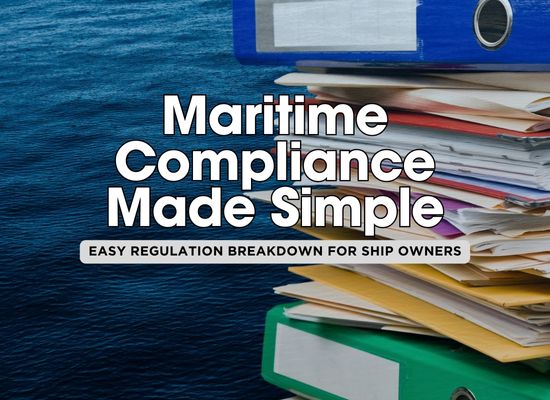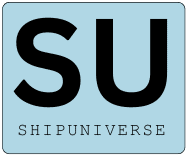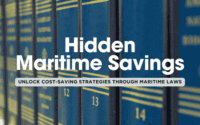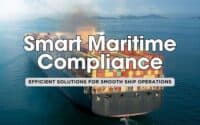Maritime Regulations in 2025: A Simplified Breakdown

Maritime regulations can feel overwhelming, with complex rules and jargon that leave many ship owners scratching their heads. That’s why we’ve created this straightforward guide—breaking down the key regulations you need to know into practical, easy-to-understand language. Whether it’s reducing emissions, managing ballast water, or preparing for ship recycling, we’ve got you covered with actionable steps and cost-saving tips to keep your operations compliant and efficient. Let’s demystify maritime compliance together! 🚢
Disclaimer: This guide provides general information on maritime regulations. While we strive for accuracy, requirements may vary by country or flag state. Please consult official sources or maritime experts to confirm compliance and stay updated. Please send any corrections, feedback, or enhancements to editor at shipuniverse.com

Main Regulations
1. FuelEU Maritime Regulation
2. EU Emissions Trading System (ETS)
3. Ballast Water Management (BWM) Convention
4. Hong Kong International Convention for the Safe and Environmentally Sound Recycling of Ships
Additional Regulations
5. MARPOL Annex VI: Regulations for the Prevention of Air Pollution from Ships
6. Ship Energy Efficiency Management Plan (SEEMP)
7. Polar Code (IMO International Code for Ships Operating in Polar Waters)
8. ILO Maritime Labour Convention (MLC), 2006
9. Biofouling Management Guidelines
1️⃣ FuelEU Maritime Regulation
🔍 What Is It?
The FuelEU Maritime Regulation, effective January 1, 2025, is part of the EU’s push to decarbonize maritime shipping. It applies to ships over 5,000 gross tonnage operating in EU ports and aims to reduce greenhouse gas (GHG) emissions by:
- Requiring ship owners to reduce carbon intensity and meet specific GHG benchmarks.
- Mandating annual fuel consumption and emissions reporting under strict EU standards.
- Encouraging the use of low-carbon fuels (e.g., LNG, biofuels, or blends) or energy-efficient technologies.
Failure to comply can result in significant fines or restrictions in EU waters, making compliance a priority for ship owners.
🛠️ Steps to Compliance
1️⃣ Evaluate Your Fleet’s Current Performance
- Conduct an emissions audit to understand the carbon intensity of your vessels. Identify gaps and areas for improvement.
2️⃣ Assess Fuel Options
- Explore compliant fuel options such as low-sulfur diesel, LNG, biofuels, or methanol. Blended fuels and fuel additives can reduce carbon intensity without requiring a complete transition.
3️⃣ Optimize Energy Efficiency
- Retrofit ships with technologies like:
- Air lubrication systems to reduce drag.
- Engine optimizations for fuel efficiency.
- Hull cleaning and maintenance to improve hydrodynamics.
4️⃣ Implement Emissions Monitoring Systems
- Use MRV (Monitoring, Reporting, and Verification) software to accurately track and report fuel consumption and emissions.
💡 Low-Cost Compliance Tip
Enhance Efficiency to Reduce Compliance Costs
- Implement slow steaming and optimized routing to cut fuel consumption and lower carbon intensity.
- Use blended fuels with bio-components to achieve GHG targets without fully transitioning to alternative fuels.
- Regularly clean the hull and propellers to reduce drag and maximize fuel efficiency.
- Leverage free tools for emissions monitoring and reporting to ensure compliance without investing in expensive systems.
📞 Points of Contact (POC)
- DNV: www.dnv.com
- Lloyd’s Register: www.lr.org
- Bureau Veritas: www.bureauveritas.com
✅ Compliance Includes
- Fuel Use: Meeting GHG benchmarks through alternative fuels or fuel optimization.
- Technology: Employing energy-saving solutions like engine upgrades and hull modifications.
- Reporting: Submitting annual verified emissions reports to EU authorities.
📜 Full Documentation
For detailed requirements and guidance, refer to the official FuelEU Maritime Regulation documentation:
https://transport.ec.europa.eu/transport-modes/maritime/decarbonising-maritime-transport-fueleu-maritime_en
🤝 Who Can Help?
- Fuel Suppliers:
- Providers of compliant fuels, including LNG, biofuels, and blends.
- Technology Providers:
- Companies like Wärtsilä and MAN Energy Solutions for retrofitting and energy efficiency solutions.
- Classification Societies:
- Certification and guidance from DNV, Lloyd’s Register, and Bureau Veritas.
2️⃣ EU Emissions Trading System (ETS)
🔍 What Is It?
The EU Emissions Trading System (ETS) is a market-based mechanism that requires ship owners to account for their CO₂ emissions by purchasing and surrendering emissions allowances. Starting January 1, 2024, shipping was included in the EU ETS, and compliance becomes increasingly stringent in 2025. The system applies to ships over 5,000 gross tonnage conducting voyages:
- Within the European Economic Area (EEA).
- To and from EEA ports.
The goal is to reduce emissions by capping allowances and encouraging energy efficiency or a switch to alternative fuels.
🛠️ Steps to Compliance
1️⃣ Calculate Emissions
- Use the EU’s Monitoring, Reporting, and Verification (MRV) system to measure CO₂ emissions from your fleet.
- Include emissions for 50% of voyages to or from EEA ports and 100% of voyages within the EEA.
2️⃣ Purchase Emissions Allowances
- Buy allowances on the EU ETS market to cover your fleet’s annual CO₂ emissions.
- Allowances are capped, with the cap decreasing over time to incentivize emission reductions.
3️⃣ Submit Verified Reports
- Annually report verified emissions and submit the corresponding allowances to the EU by the specified deadline.
4️⃣ Plan for Emission Reductions
- Implement energy efficiency measures, retrofit ships, or transition to low-emission fuels to reduce the need for costly allowances.
💡 Low-Cost Compliance Tip
Optimize Emissions and Allowance Costs
- Implement slow steaming and optimized voyage planning to reduce fuel consumption and CO₂ emissions, decreasing the need for allowances.
- Monitor emissions data accurately using existing onboard systems to avoid costly over-purchasing of allowances.
- Consider joining an emissions pooling arrangement with other operators to share the financial burden of allowance purchases.
- Leverage free or low-cost emissions calculators available online to project allowance requirements and plan ahead.
📞 Points of Contact (POC)
- EU MRV Portal: EU MRV Shipping Tool
- Classification Societies:
- DNV: www.dnv.com
- Lloyd’s Register: www.lr.org
- Bureau Veritas: www.bureauveritas.com
✅ Compliance Includes
- Monitoring: Accurate measurement of CO₂ emissions using the MRV system.
- Reporting: Annual submission of emissions data verified by an accredited verifier.
- Allowances: Purchasing sufficient EU ETS allowances to match your reported emissions.
📜 Full Documentation
For detailed requirements and allowances trading guidance, refer to the official EU Emissions Trading System documentation:
https://ec.europa.eu/clima/eu-action/eu-emissions-trading-system-eu-ets_en
🤝 Who Can Help?
- MRV Compliance Tools:
- Platforms like Verifavia Shipping (www.verifavia-shipping.com) for emissions reporting and verification.
- Trading Platforms:
- Companies or brokers facilitating ETS allowance purchases.
- Consultants:
- Maritime advisors specializing in ETS compliance and emissions reduction strategies.
3️⃣ Ballast Water Management (BWM) Convention
🔍 What Is It?
The Ballast Water Management (BWM) Convention, adopted by the International Maritime Organization (IMO), aims to prevent the spread of invasive aquatic species through ships’ ballast water. Effective since September 8, 2017, it mandates that all ships:
- Implement a Ballast Water Management Plan.
- Carry a Ballast Water Record Book to document all ballast water operations.
- Install and use an approved Ballast Water Treatment System (BWTS) to meet the D-2 discharge standard, which sets specific limits on viable organisms in discharged ballast water.
Compliance is essential to protect marine ecosystems and avoid penalties during port state control inspections.
🛠️ Steps to Compliance
1️⃣ Develop a Ballast Water Management Plan
- Create a ship-specific plan detailing procedures for ballast water management, including safety and maintenance protocols.
2️⃣ Install an Approved Ballast Water Treatment System (BWTS)
- Equip your vessel with a BWTS that meets IMO guidelines and is suitable for your ship’s design and operational needs.
3️⃣ Maintain a Ballast Water Record Book
- Accurately record all ballast water operations, including uptake, treatment, and discharge, as per IMO guidelines.
4️⃣ Train Crew Members
- Ensure crew members are trained in ballast water management procedures and the operation of the BWTS.
5️⃣ Obtain Certification
- Acquire an International Ballast Water Management Certificate from your flag state or a recognized organization, confirming compliance with the BWM Convention.
💡 Low-Cost Compliance Tip
Maximize Operational Efficiency to Reduce Costs
- Leverage grants or subsidies available in some regions for installing compliant BWTS.
- Perform regular hull and ballast tank cleanings during scheduled maintenance to minimize sediment buildup, reducing strain on Ballast Water Treatment Systems (BWTS).
- Use existing port stays to conduct ballast water exchange in open seas where permitted, lowering the need for additional treatment.
Train crew members to monitor and operate the BWTS efficiently, reducing energy and maintenance costs.
📞 Points of Contact (POC)
- International Maritime Organization (IMO): www.imo.org
- Classification Societies:
- DNV: www.dnv.com
- Lloyd’s Register: www.lr.org
- Bureau Veritas: www.bureauveritas.com
✅ Compliance Includes
- Planning: Developing and implementing a Ballast Water Management Plan.
- Equipment: Installing an approved BWTS to meet the D-2 discharge standard.
- Documentation: Maintaining accurate records in the Ballast Water Record Book.
- Certification: Holding a valid International Ballast Water Management Certificate.
📜 Full Documentation
For detailed requirements and guidelines, refer to the official IMO BWM Convention documentation:
https://www.imo.org/en/OurWork/Environment/Pages/BWMConventionandGuidelines.aspx
🤝 Who Can Help?
- BWTS Manufacturers:
- Companies providing IMO-approved ballast water treatment systems.
- Maritime Consultants:
- Experts offering guidance on compliance and system installation.
- Training Providers:
- Organizations delivering crew training on ballast water management procedures.
4️⃣ Hong Kong International Convention for the Safe and Environmentally Sound Recycling of Ships
🔍 What Is It?
The Hong Kong International Convention for the Safe and Environmentally Sound Recycling of Ships (Hong Kong Convention), adopted in 2009, aims to ensure that ships are recycled without unnecessary risks to human health, safety, or the environment. The Convention will enter into force on June 26, 2025, and applies to ships over 500 gross tonnage and the recycling facilities handling them.
Main Requirements Include:
- Inventory of Hazardous Materials (IHM): All ships must maintain an accurate inventory detailing the type, quantity, and location of hazardous materials onboard.
- Authorized Recycling Facilities: Ships must be sent to recycling facilities compliant with Hong Kong Convention standards.
- Recycling Plan: Before recycling, a ship-specific plan must be prepared to ensure safe and environmentally sound procedures.
- Certification: Vessels must carry certificates such as the International Certificate on Inventory of Hazardous Materials and a Ready for Recycling Certificate when applicable.
These requirements aim to promote safer practices and reduce the environmental impact of ship recycling.
🛠️ Steps to Compliance
1️⃣ Develop an Inventory of Hazardous Materials (IHM)
- Create and maintain an up-to-date IHM for all operational ships, including details of hazardous substances like asbestos, heavy metals, and ozone-depleting substances.
2️⃣ Prepare a Ship-Specific Recycling Plan
- Before decommissioning, work with a compliant recycling facility to develop a detailed plan for safe and environmentally sound recycling.
3️⃣ Select Authorized Recycling Facilities
- Only use facilities certified to meet Hong Kong Convention requirements. Verify their credentials to ensure compliance.
4️⃣ Obtain Necessary Certifications
- Secure the International Certificate on Inventory of Hazardous Materials and, prior to recycling, the Ready for Recycling Certificate.
5️⃣ Maintain Comprehensive Records
- Document ship design, construction, and operational changes to ensure transparency and facilitate end-of-life compliance.
💡 Low-Cost Compliance Tip
Simplify IHM Management and Recycling Preparation
- Regularly update the Inventory of Hazardous Materials (IHM) during the ship’s life to avoid costly surveys before recycling.
- Select authorized recycling facilities early to streamline processes and reduce last-minute expenses.
- Integrate IHM management into existing Safety Management Systems (SMS) for efficient record-keeping.
- Focus on high-risk areas like engine rooms and fuel tanks to prioritize resources effectively.
- Collaborate with other operators for shared crew training on recycling procedures to cut training costs.
📞 Points of Contact (POC)
- International Maritime Organization (IMO): www.imo.org
- Classification Societies:
- DNV: www.dnv.com
- Lloyd’s Register: www.lr.org
- Bureau Veritas: www.bureauveritas.com
✅ Compliance Includes
- IHM: Preparing and maintaining an inventory of hazardous materials.
- Planning: Developing a recycling plan tailored to the ship and facility.
- Certification: Carrying all required certificates, including those related to hazardous materials and recycling readiness.
- Facility Use: Ensuring the chosen recycling yard complies with international safety and environmental standards.
📜 Full Documentation
For detailed requirements and guidance, refer to the official IMO Hong Kong Convention documentation:
https://www.imo.org/en/OurWork/Environment/Pages/Ship-Recycling.aspx
🤝 Who Can Help?
- Authorized Recycling Facilities:
- Compliant yards certified under the Hong Kong Convention.
- Maritime Consultants:
- Experts to assist with IHM preparation and compliance strategies.
- Classification Societies:
- Guidance on meeting Convention requirements and issuing certifications.
Additional Regulations
5️⃣ MARPOL Annex VI: Regulations for the Prevention of Air Pollution from Ships
🔍 What Is It?
MARPOL Annex VI is an international regulation under the International Maritime Organization (IMO) aimed at minimizing air pollution from ships. It sets limits on emissions of sulfur oxides (SOₓ), nitrogen oxides (NOₓ), and particulate matter, and establishes requirements for shipboard incineration and fuel oil quality. The regulation applies to all ships operating internationally.
Main Requirements Include:
- Sulfur Content Limits: Global cap on sulfur content in fuel oil is 0.50% m/m (mass by mass). In designated Emission Control Areas (ECAs), the limit is stricter at 0.10% m/m.
- Nitrogen Oxides (NOₓ) Emission Standards: Tiered standards (Tier I, II, III) apply based on ship construction date and engine specifications, with Tier III being the most stringent, applicable in NOₓ ECAs.
- Fuel Oil Quality: Fuel oil must meet specific quality standards to ensure safety and environmental compliance.
- Shipboard Incineration: Regulations govern the types of waste that can be incinerated on board and the operation of incinerators.
🛠️ Steps to Compliance
1️⃣ Use Compliant Fuel Oils
- Source fuel oils that meet the sulfur content limits for your operating areas. Maintain bunker delivery notes and fuel samples as proof of compliance.
2️⃣ Install Exhaust Gas Cleaning Systems (EGCS)
- Alternatively, fit ships with approved scrubbers to reduce SOₓ emissions, allowing the use of higher sulfur fuels while meeting emission limits.
3️⃣ Ensure Engine Compliance
- Verify that marine diesel engines meet the applicable NOₓ emission standards. This may involve engine modifications or the installation of Selective Catalytic Reduction (SCR) systems.
4️⃣ Maintain Accurate Records
- Keep detailed records of fuel oil purchases, usage, and emissions data. Regularly update the Bunker Delivery Note (BDN) and Oil Record Book.
5️⃣ Conduct Regular Maintenance
- Perform routine maintenance on engines and pollution prevention equipment to ensure optimal performance and compliance with emission standards.
💡 Low-Cost Compliance Tip
Maximize Operational Efficiency
- Slow Steaming: Reduce engine speeds to cut fuel consumption and emissions, a simple strategy with immediate cost and compliance benefits.
- Optimize Fuel Switching: If operating in Emission Control Areas (ECAs), plan fuel switching between high-sulfur and low-sulfur fuels in advance to avoid wastage or non-compliance.
- Regular Maintenance: Perform routine hull and propeller cleanings to reduce drag, boost fuel efficiency, and lower emissions.
- Use Voyage Planning Tools: Leverage affordable or free software for weather routing and fuel-efficient voyage planning, ensuring minimal fuel use.
- Invest in Additives: Consider low-cost fuel additives that improve combustion efficiency and reduce sulfur and particulate emissions.
📞 Points of Contact (POC)
- International Maritime Organization (IMO): www.imo.org
- Classification Societies:
- DNV: www.dnv.com
- Lloyd’s Register: www.lr.org
- Bureau Veritas: www.bureauveritas.com
✅ Compliance Includes
- Fuel Management: Using fuels that meet sulfur content requirements or employing alternative measures like scrubbers.
- Emission Controls: Ensuring engines comply with NOₓ emission standards through design or after-treatment technologies.
- Documentation: Maintaining accurate records of fuel usage, emissions, and compliance measures.
- Certification: Holding valid certificates such as the International Air Pollution Prevention (IAPP) Certificate.
📜 Full Documentation
For detailed requirements and guidelines, refer to the official IMO MARPOL Annex VI documentation:
https://www.epa.gov/enforcement/marpol-annex-vi-and-act-prevent-pollution-ships-apps
🤝 Who Can Help?
- Fuel Suppliers:
- Providers of compliant low-sulfur fuels and alternative options.
- Equipment Manufacturers:
- Suppliers of exhaust gas cleaning systems and NOₓ reduction technologies.
- Maritime Consultants:
- Experts offering guidance on compliance strategies and implementation.
6️⃣ Ship Energy Efficiency Management Plan (SEEMP)
🔍 What Is It?
The Ship Energy Efficiency Management Plan (SEEMP) is a mandatory operational measure introduced by the International Maritime Organization (IMO) under MARPOL Annex VI. Its primary goal is to enhance the energy efficiency of ships, thereby reducing greenhouse gas emissions and minimizing the environmental impact of maritime operations. The SEEMP is structured into three parts:
- Part I: A ship-specific plan outlining operational measures to improve energy efficiency.
- Part II: A data collection plan for fuel oil consumption, facilitating monitoring and reporting.
- Part III: An operational carbon intensity plan, detailing strategies to achieve required Carbon Intensity Indicator (CII) ratings.
As of January 1, 2023, all ships of 5,000 gross tonnage and above are required to have a verified SEEMP Part III on board.
🛠️ Steps to Compliance
1️⃣ Develop SEEMP Part I
- Create a ship-specific plan that includes best practices for fuel-efficient operations, such as optimized routing, speed management, and regular maintenance schedules.
2️⃣ Implement SEEMP Part II
- Establish a data collection system to monitor and record fuel oil consumption, as required by the IMO Data Collection System (DCS).
3️⃣ Prepare SEEMP Part III
- Develop an operational carbon intensity plan that outlines measures to achieve and maintain the required CII ratings. This includes setting annual targets and implementing corrective actions if necessary.
4️⃣ Obtain Verification and Certification
- Submit the SEEMP to the relevant authorities or recognized organizations for verification. Ensure that the ship carries the necessary certificates, such as the International Energy Efficiency Certificate (IEEC).
5️⃣ Continuous Monitoring and Improvement
- Regularly assess the effectiveness of implemented measures, update the SEEMP as needed, and ensure crew training to maintain compliance and improve energy efficiency.
💡 Low-Cost Compliance Tip
Optimize Existing Practices for Energy Savings
- Utilize free or low-cost digital tools to monitor and report fuel usage, streamlining compliance with SEEMP requirements.
- Use your current Safety Management System (SMS) as a base to develop and update SEEMP documentation, minimizing administrative costs.
- Implement cost-effective strategies like slow steaming, optimized routing, and regular hull and propeller cleaning to reduce fuel consumption without significant investment.
📞 Points of Contact (POC)
- International Maritime Organization (IMO): www.imo.org
- Classification Societies:
- DNV: www.dnv.com
- Lloyd’s Register: www.lr.org
- Bureau Veritas: www.bureauveritas.com
✅ Compliance Includes
- Planning: Developing and maintaining a ship-specific SEEMP covering all three parts.
- Data Collection: Accurately monitoring and reporting fuel oil consumption and carbon intensity metrics.
- Operational Measures: Implementing strategies to enhance energy efficiency and achieve required CII ratings.
- Documentation: Ensuring all relevant certificates and records are up to date and readily available for inspection.
📜 Full Documentation
For detailed requirements and guidelines, refer to the official IMO SEEMP Guidelines:
https://wwwcdn.imo.org/localresources/en/KnowledgeCentre/IndexofIMOResolutions/MEPCDocuments/MEPC.346(78).pdf
🤝 Who Can Help?
- Maritime Consultants:
- Experts offering guidance on developing and implementing SEEMP.
- Data Collection Service Providers:
- Companies providing tools and services for monitoring fuel consumption and emissions.
- Training Providers:
- Organizations offering crew training on energy efficiency best practices.
7️⃣ Polar Code (IMO International Code for Ships Operating in Polar Waters)
🔍 What Is It?
The Polar Code is an international framework established by the International Maritime Organization (IMO) to enhance the safety of ships operating in polar waters and to protect the pristine environments of the Arctic and Antarctic regions. Effective since January 1, 2017, the code addresses the unique challenges posed by polar operations, including extreme weather conditions, remoteness, and the presence of ice.
Main Requirements Include:
- Ship Design and Construction: Vessels must be structurally capable of withstanding polar conditions, with appropriate ice-classification and reinforcement.
- Operational Procedures: Development of a Polar Water Operational Manual (PWOM) to guide safe operations, including voyage planning and emergency procedures.
- Crew Training: Mandatory training for masters, chief mates, and officers in charge of a navigational watch, ensuring they are equipped to handle the challenges of polar navigation.
- Environmental Protection: Strict regulations on the discharge of pollutants, including oil, chemicals, sewage, and garbage, to preserve the fragile polar ecosystems.
🛠️ Steps to Compliance
1️⃣ Assess Vessel Suitability
- Conduct a comprehensive assessment to determine if the ship meets the structural and equipment requirements for polar operations.
2️⃣ Develop a Polar Water Operational Manual (PWOM)
- Create a manual outlining specific operational capabilities and limitations, emergency procedures, and risk mitigation strategies tailored to polar conditions.
3️⃣ Ensure Crew Training and Certification
- Provide specialized training for relevant crew members in accordance with the Standards of Training, Certification, and Watchkeeping (STCW) Convention, focusing on polar operations.
4️⃣ Obtain a Polar Ship Certificate
- Apply for certification that verifies the vessel’s compliance with the Polar Code, issued by the flag state or a recognized organization.
5️⃣ Implement Environmental Safeguards
- Adopt measures to prevent pollution, including proper waste management systems and adherence to discharge restrictions specific to polar waters.
💡 Low-Cost Compliance Tip
Leverage Existing Resources and Collaborative Efforts
- Adapt your current Safety Management System (SMS) to include Polar Code requirements, reducing the need for new documentation.
- Partner with other operators for joint training exercises, sharing costs for ice navigation drills or emergency simulations.
- Utilize free resources from regional authorities, such as ice forecasts and navigation charts, to enhance crew preparedness at minimal expense.
📞 Points of Contact (POC)
- International Maritime Organization (IMO): www.imo.org
- Classification Societies:
- DNV: www.dnv.com
- Lloyd’s Register: www.lr.org
- Bureau Veritas: www.bureauveritas.com
✅ Compliance Includes
- Structural Integrity: Ensuring the vessel’s design and construction are suitable for polar conditions.
- Operational Preparedness: Developing and maintaining a PWOM tailored to the vessel’s polar activities.
- Crew Competency: Providing specialized training and certification for crew members involved in polar operations.
- Environmental Compliance: Implementing measures to prevent pollution and protect the sensitive polar environment.
📜 Full Documentation
For detailed requirements and guidelines, refer to the official IMO Polar Code documentation:
https://www.imo.org/en/OurWork/Safety/Pages/polar-code.aspx
🤝 Who Can Help?
- Maritime Training Institutes:
- Offer specialized courses on polar navigation and operations.
- Consulting Firms Specializing in Polar Operations:
- Provide expertise in developing PWOMs and achieving compliance.
- Equipment Suppliers:
- Supply necessary gear and modifications for vessels to operate safely in polar conditions.
8️⃣ ILO Maritime Labour Convention (MLC), 2006
🔍 What Is It?
The Maritime Labour Convention, 2006 (MLC, 2006), established by the International Labour Organization (ILO), sets comprehensive standards for the working and living conditions of seafarers. Often referred to as the “Seafarers’ Bill of Rights,” it consolidates and updates numerous existing maritime labor instruments into a single, coherent framework. The Convention entered into force on August 20, 2013, and applies to all ships engaged in commercial activities, with certain exceptions.
Main Requirements Include:
- Minimum Age: Seafarers must be at least 16 years old; for night work and hazardous tasks, the minimum age is 18.
- Medical Certification: Seafarers must possess a valid medical certificate confirming fitness for duties.
- Qualifications: Seafarers must have completed the necessary training for their roles.
- Seafarers’ Employment Agreements (SEAs): Contracts must be clear, legally enforceable, and incorporate applicable collective bargaining agreements.
- Hours of Work and Rest: Regulations stipulate maximum working hours and minimum rest periods to ensure seafarer well-being.
- Accommodation and Recreational Facilities: Ships must provide safe, decent living conditions and access to recreational amenities.
- Health Protection and Medical Care: Seafarers are entitled to prompt access to medical care, including essential dental care, both on board and ashore.
- Repatriation: Seafarers have the right to be repatriated at no cost under specific circumstances, such as contract termination or illness.
- Complaint Procedures: Ships must have onboard procedures for fair and effective handling of seafarer complaints.
🛠️ Steps to Compliance
1️⃣ Review National Legislation
- Ensure that your operations align with the MLC, 2006 requirements as implemented by your flag state’s national laws.
2️⃣ Develop and Implement SEAs
- Create clear and comprehensive Seafarers’ Employment Agreements that comply with MLC standards.
3️⃣ Ensure Adequate Accommodation and Facilities
- Assess and, if necessary, upgrade shipboard living and recreational spaces to meet the Convention’s standards.
4️⃣ Establish Onboard Complaint Procedures
- Implement a transparent and accessible system for seafarers to report grievances without fear of retaliation.
5️⃣ Maintain Accurate Records
- Keep detailed documentation of seafarers’ working hours, medical certificates, training records, and other relevant documents to demonstrate compliance.
6️⃣ Obtain Maritime Labour Certificate and Declaration
- Undergo inspections by the flag state or recognized organization to receive certification confirming compliance with MLC standards.
💡 Low-Cost Compliance Tip
Leverage Digital Tools for Crew Management
- Use free or low-cost crew management software to streamline compliance with seafarer documentation, employment agreements, and working/rest hour records.
- Digitally track crew medical certificates, training records, and contract renewals to avoid costly administrative errors or last-minute penalties during inspections.
- Implement online training resources to meet seafarer education requirements, reducing the need for expensive in-person sessions.
By embracing digital tools, ship owners can reduce administrative burdens while ensuring compliance with MLC requirements in a cost-effective manner.
📞 Points of Contact (POC)
- International Labour Organization (ILO): www.ilo.org
- National Maritime Authorities:
- Contact your flag state’s maritime administration for specific guidance and assistance.
- Classification Societies:
- DNV: www.dnv.com
- Lloyd’s Register: www.lr.org
- Bureau Veritas: www.bureauveritas.com
✅ Compliance Includes
- Seafarer Welfare: Ensuring fair employment terms, safe working conditions, and access to medical care.
- Living Conditions: Providing adequate accommodation, food, and recreational facilities on board.
- Employment Practices: Maintaining transparent recruitment, placement, and repatriation procedures.
- Health and Safety: Implementing measures to protect seafarers’ health and prevent accidents.
📜 Full Documentation
For detailed requirements and guidelines, refer to the official ILO Maritime Labour Convention, 2006 documentation:
https://www.ilo.org/international-labour-standards/maritime-labour-convention-2006
🤝 Who Can Help?
- Maritime Labour Consultants:
- Experts who can assist in aligning your operations with MLC, 2006 standards.
- Seafarers’ Unions:
- Organizations that advocate for seafarers’ rights and can provide guidance on compliance.
- Training Providers:
- Institutions offering courses to ensure crew members meet the Convention’s qualification requirements.
9️⃣ Biofouling Management Guidelines
🔍 What Is It?
The Biofouling Management Guidelines are international standards developed by the International Maritime Organization (IMO) to address the accumulation of aquatic organisms on submerged surfaces of ships, known as biofouling. Biofouling can lead to the transfer of invasive aquatic species across marine environments, posing ecological and economic risks. The guidelines aim to provide a globally consistent approach to managing biofouling, thereby minimizing the spread of invasive species and improving vessel efficiency.
Main Recommendations Include:
- Biofouling Management Plan (BFMP): Develop a ship-specific plan detailing procedures for biofouling management, including inspection, cleaning, and maintenance strategies.
- Biofouling Record Book (BFRB): Maintain a record of all biofouling management activities, such as inspections, cleaning operations, and the application of anti-fouling systems.
- Selection and Maintenance of Anti-Fouling Systems (AFS): Choose appropriate anti-fouling coatings and ensure their regular maintenance to prevent organism attachment.
- Regular In-Water Inspections and Cleaning: Conduct periodic inspections and cleanings of the hull and niche areas to manage biofouling levels effectively.
- Design and Construction Considerations: Incorporate biofouling management measures during the ship design and construction phases to reduce biofouling accumulation.
🛠️ Steps to Compliance
1️⃣ Develop a Biofouling Management Plan (BFMP)
- Create a comprehensive plan tailored to your vessel, outlining procedures for biofouling management, including inspection schedules, cleaning methods, and maintenance practices.
2️⃣ Maintain a Biofouling Record Book (BFRB)
- Document all biofouling management actions, such as inspections, cleaning operations, and anti-fouling system applications, to demonstrate compliance and facilitate audits.
3️⃣ Select and Apply Appropriate Anti-Fouling Systems (AFS)
- Choose effective and environmentally friendly anti-fouling coatings suitable for your vessel’s operating profile, and ensure proper application and maintenance.
4️⃣ Conduct Regular In-Water Inspections and Cleaning
- Implement a schedule for periodic inspections and cleanings of the hull and niche areas to manage biofouling levels, considering the vessel’s operating areas and conditions.
5️⃣ Incorporate Biofouling Management in Ship Design
- During the design and construction phases, consider features that minimize biofouling accumulation, such as smooth hull surfaces and accessible niche areas for cleaning.
💡 Low-Cost Compliance Tip
Utilize Opportunistic Cleaning During Port Stays
- Take advantage of idle time during port stays to perform in-water inspections and minor cleaning tasks. This proactive approach helps manage biofouling early before it becomes extensive and costly.
- Focus on niche areas, such as rudders, propeller shafts, and sea chests, where biofouling tends to accumulate most. Addressing these areas during routine stops can prevent performance issues.
- Collaborate with local service providers for quick, cost-effective cleaning instead of full-scale hull cleaning operations.
📞 Points of Contact (POC)
- International Maritime Organization (IMO): www.imo.org
- National Maritime Authorities: Contact your flag state’s maritime administration for specific guidance and assistance.
- Classification Societies:
- DNV: www.dnv.com
- Lloyd’s Register: www.lr.org
- Bureau Veritas: www.bureauveritas.com
✅ Compliance Includes
- Developing and Implementing a BFMP: Establishing a tailored plan for managing biofouling on your vessel.
- Maintaining a BFRB: Keeping detailed records of all biofouling management activities.
- Selecting Suitable AFS: Choosing and maintaining effective anti-fouling coatings.
- Conducting Regular Inspections and Cleanings: Implementing scheduled maintenance to control biofouling levels.
- Considering Biofouling in Ship Design: Incorporating features during design and construction to minimize biofouling accumulation.
📜 Full Documentation
For detailed requirements and guidelines, refer to the official 2023 IMO Biofouling Guidelines:
https://wwwcdn.imo.org/localresources/en/KnowledgeCentre/IndexofIMOResolutions/MEPCDocuments/MEPC.378(80).pdf
🤝 Who Can Help?
- Maritime Consultants Specializing in Biofouling Management:
- Provide expertise in developing BFMPs and selecting appropriate anti-fouling systems.
- Anti-Fouling Coating Manufacturers:
- Offer products and guidance on suitable coatings for various vessel types and operating conditions.
- Hull Cleaning Service Providers:
- Conduct in-water inspections and cleaning services to manage biofouling effectively.
Table Summary
| ShipUniverse: Essential Maritime Regulations Summary | ||||
|---|---|---|---|---|
| Regulation | Description | Key Steps | Low-Cost Tip | Full Documentation |
| 1️⃣ FuelEU Maritime Regulation | Reduces greenhouse gas emissions in EU ports. | Use compliant fuels, monitor emissions, and submit annual reports. | Blended fuels and slow steaming can meet targets affordably. | View Documentation |
| 2️⃣ EU Emissions Trading System (ETS) | Requires purchasing allowances for CO₂ emissions. | Monitor emissions, buy allowances, and report annually. | Optimize routing and slow steaming to reduce allowances needed. | View Documentation |
| 3️⃣ Ballast Water Management Convention | Prevents the spread of invasive species via ballast water. | Install approved BWTS, maintain records, and follow IMO standards. | Perform ballast exchanges in open seas to reduce treatment needs. | View Documentation |
| 4️⃣ Hong Kong Convention | Ensures safe and sustainable ship recycling practices. | Maintain an IHM, select certified facilities, and prepare a recycling plan. | Update the IHM during operations to avoid costly surveys later. | View Documentation |
| 5️⃣ MARPOL Annex VI | Regulates sulfur and nitrogen emissions from ships. | Use low-sulfur fuels, install scrubbers, and maintain emissions records. | Regular hull cleaning and slow steaming lower emissions and costs. | View Documentation |
| 6️⃣ Ship Energy Efficiency Management Plan (SEEMP) | Improves energy efficiency and reduces fuel usage. | Develop SEEMP Parts I, II, and III, and monitor fuel use. | Incorporate SEEMP updates into your Safety Management System. | View Documentation |
| 7️⃣ Polar Code | Ensures safety and environmental protection in polar waters. | Develop a PWOM, obtain ice-class certification, and train crew. | Adapt existing safety management practices to meet requirements. | View Documentation |
| 8️⃣ Maritime Labour Convention (MLC) | Protects seafarers’ rights and ensures fair working conditions. | Provide compliant contracts, accommodations, and medical care. | Use digital tools to manage documentation and reduce costs. | View Documentation |
| 9️⃣ Biofouling Management Guidelines | Reduces the spread of invasive species via biofouling. | Develop a BFMP, maintain records, and perform hull inspections. | Inspect and clean the hull during port stays to save costs. | View Documentation |

Do you have a Maritime Product or Service that may be of interest to Shipowners? Tell us about it here!
Do you have feedback or insights? Please reach out to editor @ shipuniverse.com



